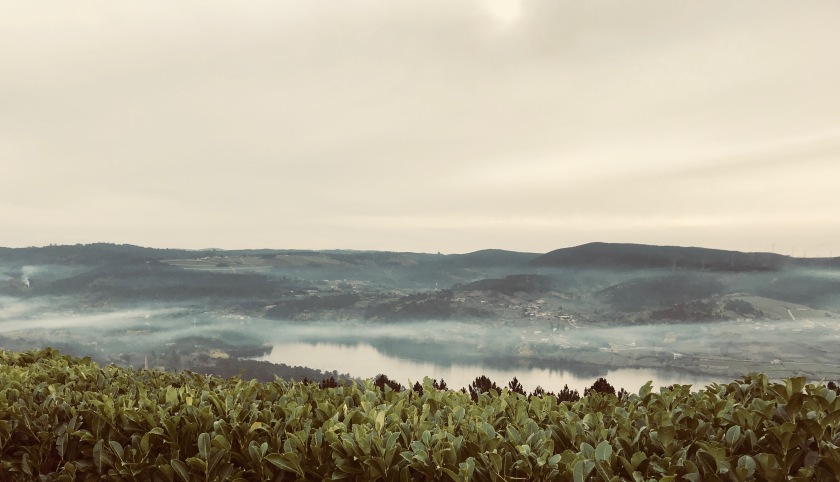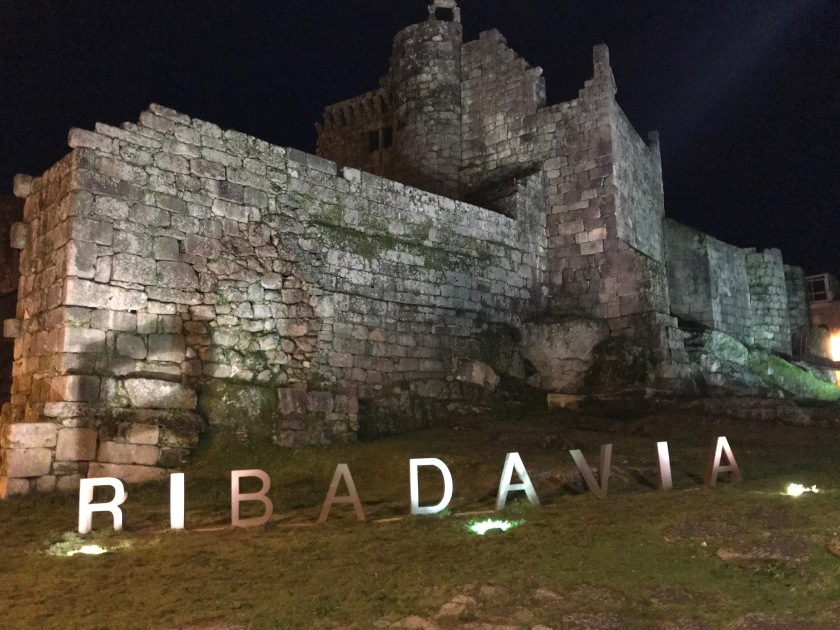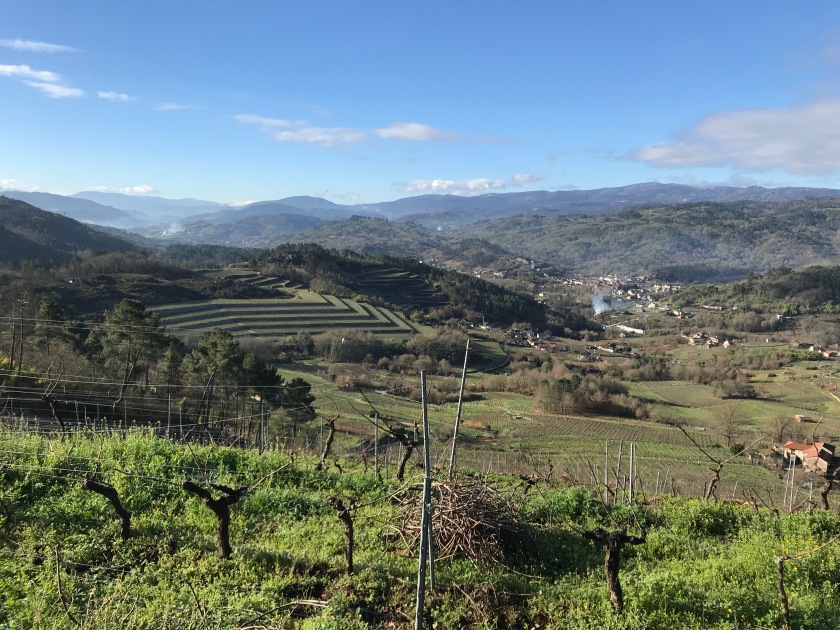As I landed in a cloud draped upon Vigo in Galicia, I searched for the Atlantic in vain. But I could smell it as I walked outside and climbed inside the taxi. Not fifty minutes later and several rolling hills, we marched over one small mountain range and into the land of Ribeiro–a tiny little wine region of not 6,000 ha under vine.

A region defined by deep valleys cut through by the Mino River and its surrounding streams, Ribeiro is not quite maritime, but not quite continental or Mediterranean either. This unique corner of the earth endearingly dabbles in them all. Picturesque terraced vineyards paint the hills. They seem to selfishly steal away gluttonous amounts of dreamlike panoramic views from the rest of the world.
Ribeiro sits just on the northern border of Portugal but nestled in Spain; it gazes out east at its more famous Galician neighbor Rias Baixas. Like its neighbor, it prides itself upon white varieties– comprising nearly 90% of the grapes here, though that number is beginning to change, as the climate warms and folks are finding a more willing market for its reds of Brancellao, Caino, Ferron, Mencia and Souson. Where Palomino took the lead under Franco’s power, quality-driven indigenous grapes like Treixadura, Godello and Albarino are eagerly taking its place with renewed focus in the region for leading wineries.
Galicia as a whole is steeped in history. It is woven into the words of every grower I met with on this glimpse of a trip. They spoke as if alluding to their grandparents but extending this to the Roman times when grapes were introduced to the area around 200 ad. With hills as green as tulip leaves and painted with relics from the 11th and 12th century, Galicia’s Celtic tradition resonated. Cistercian monks of the Monasterio de San Clodio (a pretty fascinating place we were able to visit–now turned luxury hotel) contributed to its flourishing reputation–one that even found fame in the Americas by way of Columbus. Old pigeon coups and monasteries peppered the landscape and deepened this region’s patina; their cultural past was carefully crafted within everyone’s narrative.
The medieval town of Ribadavia wore the soil in its suit– granite covered the ground beneath and composed the buildings above, emitting a mineral aroma so distinct when it began to rain. Each morning was draped in fog, and January is already the rainy season here, so it seems wet granite is a scent that is synonymous with this region.

If you can imagine, there are 3,000 growers in this small region. At an average of 2 ha per grower, you might be wondering how they manage. Under the laws of inheritance, the land began to subdivide in the 17th and 18th centuries until today. Hence, family members have been left with a row here, a row there and often not near one another. But whether it was industrialization, war, phylloxera or dictatorship, the Galician people are proud, and little will convince them to part with their parcels. And so, many will even go so far as to abandon if not lease them out to other producers in the area, so as not to sell what is rightfully theirs. There are only about a hundred or so wineries in this region altogether, with a co-op and a couple larger wineries assuming much of the land area in production. Nearly 90% of the growers produce less than 10,000 bottles of wine.
In our visit, we were meant to see a range of producers–from small, family run wineries to larger cooperatives. Our first day began in Bodego Coto do Gomariz in the coveted Avia valley, where land is some of the most expensive in the region for its ideal southerly orientation and complex granite, schist and clay soils. Gomariz did their best to collaborate among family members so parcels would not subdivide too obnoxiously, and the Carreiro family is one of only a handful fortunate to have land here– a whopping 28 hectares which is quite sizable for Ribeiro, especially for a family farm. They have made concerted efforts to practice biodynamic in recent years and are growing more pleased with the results every passing vintage. These wines were thoughtful and offered such a range of style, variety and purpose. Some, like The Flower and the Bee white and red, were fun and whimsical. Others, like the Colleita de Seleccionada blanco and the Seica tinto are more serious and long-lived bottlings coming from some of the best single vineyards in their possession. Their website demonstrates their focus and dedication to quality with beautifully detailed technical notes. It was an inspiring visit, to say the least, and it was apparent that they there are committed to enhancing Ribeiro’s reputation and bottling its unique terroir.

Later that day, we continued nearby and Finca Vinoa, which provided some of the most spectacular overlooks of Ribeiro and impressively steep terraced vineyards. We were fortunate to enjoy these views while sipping on their namesake blanco from 2014, 2015 and 2016–the same bright, youthful unoaked bottling of mostly Treixadura balanced with other indigenous varieties. This allowed for a really understanding of vintage differences. Where 2014 was quite lean, mineral and noted with lime zest, the warm 2015 was much rounder, nuttier and creamy due to some lees aging. Marmalade and ripe peaches filled the midpalate here. The 2016 was more reminiscent of the 2014, but it too saw some lees and meandered into a more lemon citrus edge than lime.
Our experience the next day at Pazo do Mar was very educational and fun. The head winemaker walked us through their modern facility and was able to explain the many ways in which they have worked to improve the quality– adhering to traditional grapes and styles while embracing many technological advantages to make the most of their produce. I envisioned their Pazo do Mar blanco and next level up Expresion (100% Treixadura) having a lot of versatility in many U.S. markets– they were clean, reflective of place and really well priced. The winery itself had such a welcoming feel, too. They put out a beautiful spread of the region’s most typical dishes (polpo, local cheeses, jamon, tortilla, Galician empanada, local bread, and maybe the most amazing tarta de requeson–Galician cheesecake). I’m a bit hungry now just reminiscing…
We spent an unforgettable afternoon exploring nearby Galician-Roman ruins at Castro de San Cibrao de Las, where we witnessed the unearthing of a civilization that dates back to the 5th and 6th centuries B.C. Even if you suppose this wouldn’t impress you, you are wrong, and this is not to miss if you visit Ribeiro. The history is startling. Approaching the ruins, even 20 feet away, the detail and grandeur are understated… it takes walking through the old rooms and what likely were stables, kitchens, and patios of yesteryear. Absolute unexpected highlight of the trip. Rodrigo was our guide–if he is there, request him. His enthusiasm and knowledge is vast and infectious.
We then carried on at Priorato de Razamonde with the most charming elderly Pepe Perez and his gorgeous nieces Elena and Paloma Gonzalez. This family operation began with barely one hectare and they have impressively accumulated 28 hectares. Their wines were more than solid representations of Ribeiro and what’s more, their drive to raise its reputation will involve building a wine bar, restaurant and gourmet goody shop on their property for tourism this coming year. They were clued in to social media and genuine in their desire to grow their family’s business in a way that would benefit the region as a whole.
A final day began at Vina Costeira winery– at fifty years old, it is the largest winery in Galicia making D.O. wines. Still, compared to some mass production facilities around the world, this seemed rather small in comparison. The Verema awards named it the best winery in Spain in 2017. About 40% of their production functions off cooperative purchasing of fruit, and they own the rest of their vineyards. It was an educational tour followed by a tasting of nearly thirteen wines, including a sparkling wine– the first that will be allowed to wear the D.O. Ribeiro on the label this year. Done in the traditional method on the lees for 18 months and a modest 6 g/l dosage, it was a fantastic alternative to Cava– one of my favorites of the flight, in fact.
We ended our travel at another sizable winery: Bodegas Alanis. They work with over 200 growers in the area to deliver on a range of value driven, regionally expressive whites. Their top of the line San Trocado and Gran Alanis were the ones that caught my attention most, using the native varieties to best achieve more complexity in the bottle.
And so, with that, the trip concluded. We spent our nights at Laias Caldaria in the heart of Ribeiro and a short drive from the village of Ribadavia. It had natural mineral baths that were a perfect way to begin or end each day. We dined at a few really nice places, but my favorites included: Gastrobar O Birrán restaurant in Ribadavia, Veleiro Restaurant in Cenlle (a dive-y little bar with great local bites) and Peregrinus Restaurant in Ourense for a focused polpo (octopus) menu. In general, Ourense was a terrific larger small town to wander round, do lots of shopping and wine bar hopping.
The quiet pocket of Ribeiro is certain not to be secret for long, as their quality continues to improve with advanced understanding of what their soils and grapes can give a glass. Wineries are working to find ways into international markets with vibrant, bright indigenous whites from the regions. And Ribeiro itself proves charming to be an insufficient word. I was so grateful to have a few days in this little corner of paradise. My appreciation most directed to April Cullom, President of Global Bridges LLC, who shines a light on the amazingness Spain has to offer in food and wine. She is also a winemaker in her own right which I was able to samples with her Alma de Vino Mar y Montano blanco.






